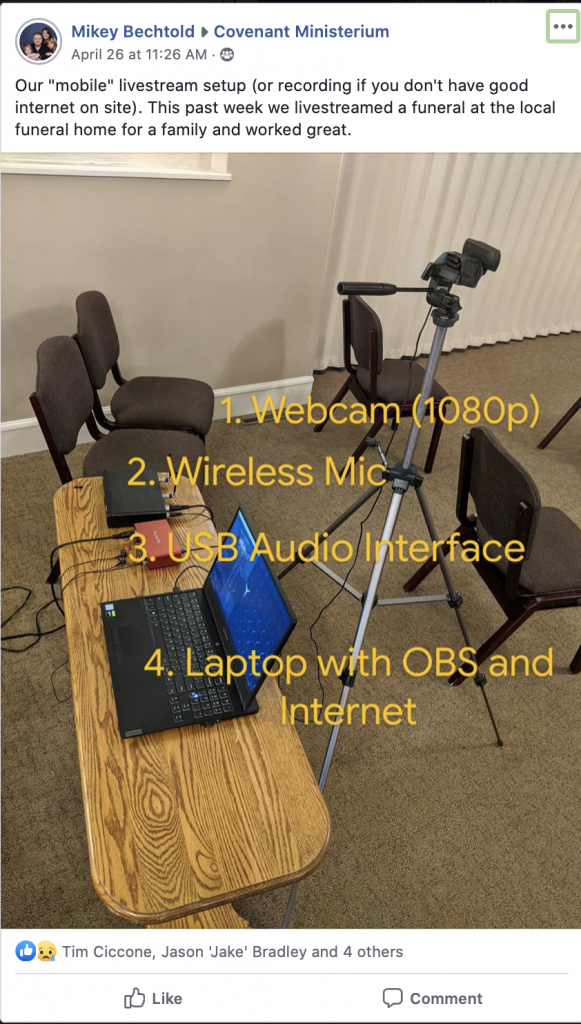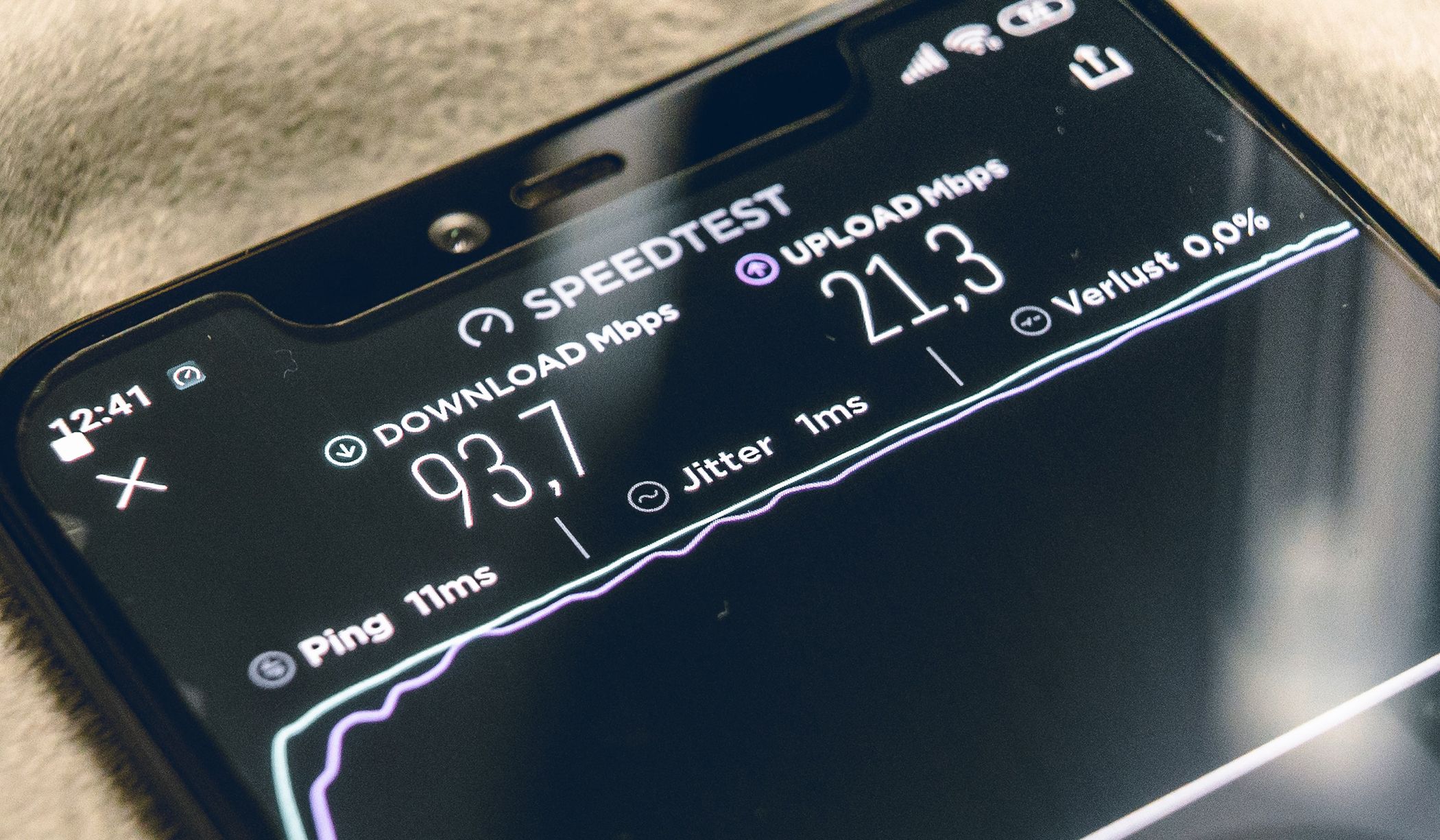A strong marketing and communication strategy can make the most of readily available, low cost tools to keep your congregation engaged and get your church in front of new audiences. As more churches and public spaces open up throughout 2021, now is the time to consider how the pieces of your brand, website, and marketing efforts work together.
In a series of previous stories, we’ve taken a close look at questions and process related to branding and website design. If you missed those four stories, see the links at the end of this article.
Once your brand is buttoned up, and your website is meeting your visitors’ and congregation’s needs, it’s time to start expanding your reach and driving traffic to the site. Think of your website as the hub of your marketing efforts—and email, social media, print and other tools as your primary drivers to the site.
Here are a few of the essential marketing platforms every church should consider using to connect with people.

Email newsletters are common ground.
An email newsletter is one of the best ways to communicate regularly with your congregation. People all have their preferred social media platforms, but virtually everyone has email. And there are many great options for free or relatively inexpensive email marketing platforms.
The two most common, and most user-friendly services are:
- MailChimp: Featuring a more advanced and easier to use email builder, MailChimp is free for users with under 2,000 contacts, making it a great fit for most churches.
- Constant Contact: The email platform of choice for the NWC, Constant Contact pricing starts at $20/month, and there are more pre-designed templates to choose from, as well as a recently improved email builder. Contact management and email archiving options are slightly more user-friendly on Constant Contact, but the trade off may not be worth the cost for most users.
A weekly email newsletter provides consistency and opportunities to drive traffic to the website. Keep in mind that people scan content quickly, and you will need to repeat important event promotions and other key content for several weeks before many will take notice and click to learn more.
Provide short blurbs that link to longer form content on your website. Give your readers just enough info to glean key details, and entice them to click links or buttons to learn more or register for events.
Social media is for viral content.
The goal in using all social media platforms is to create content that compels people to interact and share. Unlike email newsletters, social media tools are, by design, meant to connect your church with new people via the social networks of those who already follow.
Regardless of the platform, try to include specific calls to action, prompts to share, and questions that require a response. It may feel “pushy” or inauthentic at times, but social media users are accustomed to being asked to like, share and comment. So go ahead and ask away.
The three social media platforms that work well for most churches are:
- Facebook: Although it’s become overrun with advertising and hot-button political content, Facebook still has the most robust tools for churches to facilitate groups, promote events, and share a wide variety of types of content.
- Instagram: Focused on photo and video content, Instagram is a great way to give followers visual insight into the life of your congregation. Make sure to vary your content so the feed doesn’t become exclusively promotional in nature. Check out the Crossroads Church feed for a great example of content mix.
- YouTube: While it’s a great platform for hosting video and livestreaming, remember that YouTube is at its core a social media tool. Make sure to pay attention and respond to comments, and tag content to increase the likelihood of showing up in the platform’s powerful search tool.
With any social media platform, plan to drive some content to your website for event details, sermons and news items, but do make sure to mix it up with posts that are created purely for social media. This will add to the personal and interactive feel of your feed.
Print is not (quite) dead.
Most churches have cut way down on common print materials like bulletins, printed newsletters and other paper goods. Depending on the demographics of your congregation, you may even be entirely paperless. Or you may find that your particular audience still likes to hold onto an order of service or receive mail from the church.
There is no right answer here, except to stay tuned to the needs of your congregation. Even if you’re mostly paperless, consider investing in well-designed welcome packets and seasonal promotions.
For example, during the 2020 holiday season, one church located just west of the Twin Cities created a custom printed Advent calendar with daily spiritual activities for families to engage in while they weren’t able to gather. The campaign connected families worshipping at home across the church body and was a huge success.
Whatever stage your church is at in the development of your brand, website or marketing strategies, it’s important to remember that there’s always room to grow and learn and evolve. And it’s perfectly fine to think of these areas of ministry as a journey. The important thing is to start somewhere, stay active, keep moving and be flexible.
For other stories in our Communications 101 series, visit:
- Brand 101: 2021 presents opportunity to evaluate brand identity as every church ‘relaunches’
- Brand 101: How do you go about evaluating and updating your brand identity?
- Website 101: Questions to answer before redesigning your church website
- Website 101: How do you go about updating your church website?
By Bryan Malley, NWC Director of Communications
Redesigning a website is no small task. There is a lot of information to gather, hundreds of decisions to make along the way, and many hours required to plan, design, build and launch a successful project.
The job may seem daunting at times, but as the “new front door” of your church, your home on the web must get the attention it deserves. And as noted in Part 1 of this series, now is the time to consider updating your online presence as we move toward re-opening public spaces.
Whether you’re working with a website design agency, a freelancer or a team of volunteers from within your church, keep your project committee small (3-5 people), make sure you have input from key decision makers from the start and try to have a single point person for designers and developers to work with.

Process: How do you get started?
As with most any type of design project, a website redesign should begin with conversation. There is a lot to think about—and even more to do—once you get started.
Here are a few of the questions often used by professional designers at the start of a website project:
- List 3-5 main goals for your new website. (Examples: Drive traffic to contact the church, convert site visitors to church visitors, explain ministry offerings, promote events, etc.)
- Define 3-5 key audiences the new website must reach. Include as much information as you can about the demographics and expected behavior of each group as they interact with the new website. For example, a key audience of young families might be expected to search out information on children’s ministry programming over other types of content.
- Provide a short description of your brand using language that describes the “personality” of the brand.
- Are there clear colors, styles of illustrations, graphics, functionality or anything else you absolutely need to avoid because of history or the specifics of your audience?
- List the URLs of as many of your “competitor’s” websites as possible. How are you different from your main competitors?
- List the URLs of any and all inspiration websites you can think of. Provide examples from other churches and from any other sites in other industries you feel have qualities you’d like to see in your new site.
- Describe any unique functionality or how you’d like particular features to work on your new site. Are there external systems the new site needs to integrate with, such as a church database or email newsletter platform?
The answers to these questions should help guide all the decisions that will be made along the way related to words, images, organization and design elements that will come together to comprise the new site.
Start with UX Design …
User Experience Design (often referred to as UX Design), as the name suggests, is the practice of thinking through expected and desired user behavior and organizing a website and its pages in a way that will meet the visitor’s needs most effectively. UX Design includes creating a “site map” of pages, as well as planning what will go on each page from top to bottom.
Plan a site menu structure that uses plain language and is organized with the new visitor in mind. You may have developed some catchy language for your ministry priorities or individual ministry areas, but often these terms don’t make strong navigational items for those who don’t already know what they mean.
A good rule of thumb for your top level menu is to have 7 (+/-2) items that can house most of the other pages required to fill out the site. Some common examples include: Welcome, Ministries, About Us, Events, News, Contact, Giving.
Once you have a complete and organized list of what will go where, you can start to think about the individual pages of your new site.
- Home Page: The most important page on your site, it’s a good idea to start with broad messaging for new visitors, use pictures wherever possible, sprinkle in brand messaging and funnel down to specific promos for things like events, sermon series or news.
- Landing Pages: Are there certain pages on the site that deserve extra hierarchical and/or design attention? Significant design energy will go into the Home Page, but often there’s a second tier of important pages that also require strong design. Examples of Landing Pages might include: I’m New, Events, Sermons or a Ministries page that provides a simple overview of your key offerings and links out to specific pages.
- Standard Pages: Can you create a template that would serve most other page needs? Because church websites often require a higher page count to ensure each group or ministry is represented, you will save significant time and energy if you can plan a single page template with the components required to cover the bulk of the sites third tier pages.
Before you start the Visual Design process, your team should already have a clear vision for how these key page types will take shape, and how a visitor will move through the site.
Visual Design should flow from brand identity.
The UX Design plan, coupled with details about your brand identity, will be the jumping off points to move into this next stage. Visual Design should bring together color, type styles, photos, icons and other graphic elements and result in a website that “feels” like your church.
- The website is a digital extension of your church, and therefore should always flow from the brand identity.
- Use real photography of real people to give an accurate sense of what your church community is like.
- The visual hierarchy of every page should follow your content hierarchy. Bigger, bolder, simpler things go at the top, working downward to more specific, longer form content as needed.
- White space, simplicity and large text are your friends. These design qualities will keep things uncluttered, improve accessibility for users with special needs and keep the new visitor from feeling overwhelmed.
It’s important to visitors as they navigate your site to lean on visual cues that feel familiar. Avoid the temptation to break the mold and be overly creative with placement of key elements from page to page. Certain pages will vary in obvious ways, but visitors should always feel like they’re still within your website.
Why does mobile responsive design matter?
With the proliferation of mobile devices, it’s absolutely critical to make sure your website is mobile responsive. In other words, the display of the website should adjust based on the pixel width of the screen upon which it’s being viewed. According to an article from Sweor called, “27 Eye-Opening Statistics About User Experience, Website First Impressions, and Website Design That You Should Be Taking Very Seriously”:
- 57% of internet users say they won’t recommend a business with a poorly designed website on mobile.
- 85% of adults think that a company’s website when viewed on a mobile device should be as good or better than its desktop website.
Your designer should provide you with layouts for larger desktop monitors, as well as specifically-designed versions of pages for tablets and mobile phones. Often the elements of each page will stack on top of one another, some desktop design elements may be hidden for mobile devices and your site’s menu should feature a mobile-friendly design.
Content and SEO go hand in hand.
Most church website projects will have many stakeholders contributing ideas for what should go on the various pages of the site. In order to maintain a consistent brand voice, and to capitalize on Search Engine Optimization (SEO), there should be one team member aggregating and editing the words for your website.
Here are a few important things to keep in mind:
- Use welcoming and inviting language, not insider speak, to ensure your messaging resonates with new visitors.
- Most internal pages of the website should aim to have 500-750 words on the page. Too much or too little could result in dings against search rankings.
- Determine a key word or phrase for each page, and try to make sure that word appears in the meta description (the snippet shown in search results), first headline and several times throughout body copy on the page.
- Consider using tabs or other methods of organizing less important content for pages that need to house a lot of details.
- Based on your UX Design plan, provide a framework to ministry leaders or staff members submitting content. This helps them tailor their content, along with word counts, and standardizes information delivery from page to page.
You can certainly take SEO further using add-on tools, plugins and tactics to improve your organic search results, but the best starting point for most churches is to remember these basics when drafting content for your pages. Google and other search engines mainly want to know that you’re the “expert” on your specific content. Writing with SEO in mind by having the right amount of content on each page and using keywords enough, but not too much, should result in strong SEO over time. Having strong SEO means that when people search for “church in Warroad, MN” or “youth ministry in Grand Forks” your church will rise to the top of their search results list.
What Content Management System (CMS) is best?
There are myriad options for platforms on which to build a website and almost as many opinions about which CMS is best. The “right answer” to this question is probably a combination of your church’s needs for functionality, your developer’s preferences and your comfortability with the administrative interface for updating the new site.
- Avoid using proprietary CMS options offered by some software developers. These lesser-known platforms don’t have the benefit of open-source development, have less user-friendly interfaces and sometimes result in clients needing to pay for simple changes.
- WordPress is a great option for stand-alone or self-hosted sites with a large enough budget to customize the CMS and front-end design. An experienced design team can do just about anything using WordPress as the underlying platform, without the restrictions of some of the more common hosted platforms below.
- SquareSpace and Wix are good options for simpler projects that don’t require a lot of developer customization. Both platforms offer templates and easy to use page builders for putting together a site without much code knowledge.
With strong design and content, your website has the potential to convey a lot about your brand identity, give new visitors a glimpse into what your church is like, serve your members and attendees with the most up to date info and become the hub for other marketing and communications efforts.
This article is the second in a two-part series on church websites. To read part one, click here.
Also, be sure to check out our two-part series on branding at the links below:
- Brand 101: 2021 presents opportunity to evaluate brand identity as every church ‘relaunches’
- Brand 101: How do you go about evaluating and updating your brand identity?
By Bryan Malley, NWC Director of Communications
Maybe you’ve heard the phrase “your website is the new front door” of your church. While it’s true that people may first come into contact with your congregation through a variety of sources, your website is still the number one place most will turn when taking a closer look.
Every day, people in communities across the Northwest Conference are searching for a church. Even before the COVID pandemic—and even more so because of it—they are far more likely to visit your website before checking out a Sunday service.
Your website is a digital extension of your church. Are visitors getting an accurate and enticing glimpse of your brand and what your church has to offer?
Before discussing how to approach the process of a website redesign, there are some big important questions to answer first.

Who is your website for?
In my experience, having been a part of many church website projects over the years, the question of who the website exists to serve might be the most overlooked.
The conversation often begins with, “We need a new website, and we need it to do this, that and the other thing.” Most of those requests for features and functionality revolve around serving existing members and attendees.
It is definitely possible to design and build a website that meets those needs and more, but a church website should exist primarily for the new visitor. Here’s why: Those who are already a part of your community can be trained to find information about events, sermons and all the other important details of church life over time. You only have one shot to capture the attention of the new visitor, so you must meet their needs in the first few seconds of their visit.
However they arrive at your site, the number one question a new visitor is asking—either consciously or subconsciously—is, “Will I fit in here?” Your goal is to help answer that question quickly with the words and images that are used on the home page and throughout the website.
- Use real photography of real people to give an accurate sense of what your church community is like
- Use welcoming and inviting language, not insider speak, to ensure your messaging resonates with new visitors
- Give new visitors a clear path to an area of the site with detailed information about what they can expect during a first visit, the core beliefs of your church and the ministry work you do
The truth of the matter is only the new visitors that are actually a good fit for your church family will stick in the long run. So it’s important that you focus on giving new visitors a realistic vision of who you are, and work to attract the people most likely to resonate with your church experience.
Why does design matter so much?
Studies show it takes about 0.05 seconds for users to form an opinion about your website, and first impressions are 94% design-related. This becomes the key factor in determining whether visitors stay or leave.
A visitor’s perception of your website carries over to the way they perceive your church as a whole. Is it trustworthy? Does it seem credible? Is the user experience and navigation of the site intuitive and similar to what’s expected?
Why is performance important?
Modern, responsive websites that load quickly and are built on solid user experience design deliver instant credibility. And credibility keeps users on your site longer, increases interaction with the site’s calls to action and is likely to result in people recommending the site to others.
On the other hand, users will bounce quickly from sites that load slowly, aren’t compatible across a range of devices, or are frustrating to move around. Before you start down the path of designing a new website, spend time evaluating your options for hosting and site organization.
How will you keep it fresh?
Stale, dated content or imagery will also cause new visitors to question how active your church is in real life. Before embarking on a project of this scale, or creating new features that require regular posting, consider whether you have the staff or volunteer infrastructure in place to keep content fresh.
Upkeep your website like you do your building, especially since it’s your “new front door.”
This article is the first in a two-part series on church websites. In Part 2 of Website 101, we’ll take a look at a process for engaging a website redesign project.
By Bryan Malley, NWC Director of Communications
The human brain is programmed to identify things quickly. If something is not clearly labeled, we will automatically give it our own label. Branding is about attempting to control what label gets applied to your church via brand identity—messaging, visuals and experiences.
In a healthy brand environment, decisions about website design, promo material design, social media and marketing visuals, signage, apparel and more all flow from the curated brand identity.
So how do you go about distilling the big ideas about your brand down to actionable words and visual elements you can use to help control the narrative?

What’s a healthy process for brand identity creation?
Every freelance designer, small design studio or large branding agency has a unique process to guide clients through branding. While brand designers often approach the challenge in their own way, the process always involves a funnel-like method aimed at distilling many points of information down to a set of parameters that can be used to develop symbolism, styles, colors, words, logos and much more that communicate brand identity effectively.
Here’s an outline of the questions and process often used by professional designers to create visual identities that reflect the essence of the brand identity.
- What is your mission?
- What is your vision?
- What are your core values?
- What does your church do on a practical level?
- What does the name of your organization mean to you?
- What is your positioning statement (often called a tagline)?
- Define your 3-5 key audiences and provide as much demographic information as you can about the expected behavior of each group as they interact with your brand.
- What is the personality of your brand? To spur your thinking in this area, ask yourself: “If someone were to describe your church as if it were a person, what characteristics would they use?”
- What visual characteristics of your brand might capture the key aspects of your mission, vision, values and position?
- What imagery might capture some of the conceptual ideas from Mission, Vision, Brand Characteristics and Positioning Statement?
- Are there color, styles of illustration or photography that should be avoided based on history or specifics of your key audiences?
- List similar organizations and competitors and define how you are different from them.
An experienced brand designer will take your church’s input on these questions, help identify challenges and opportunities, point out conflicting inputs and ask follow up questions designed to gain a deep understanding of who you are and who you want to be, before putting pen to paper to create anything visual.
This outside perspective will often bring new ideas to the forefront, challenge existing assumptions and should result in a tightly defined and agreed upon plan to move forward in the creation of brand messaging, strategy and visual identity, often called a Creative Brief.
Whether you choose to work with an experienced team or agency, or a less experienced freelancer in the creation of the visuals, it’s absolutely critical that there is a process in place to guide design. The results of the process will be the lens through which you evaluate the success of proposed visual solutions and all future design, marketing and communications efforts.
How do you choose a partner?
The visual identity systems that best communicate brand identity don’t stop with a logo. In fact, I’ve heard a logo described as the “period at the end of the sentence,” or the flag you fly to identify yourself. This is because no logo can say all there is to say about a brand identity. It’s but one tool in a toolbox—and all the tools in the toolbox will be needed to help with the fix.
Graphic design, as a profession, covers a wide range of areas of expertise. There are illustrators, publication designers, website designers, production designers, font designers and on and on.
If you’re searching for a partner to guide you through branding, it’s important to connect with a person or team that can show experience in creating and executing a brand identity system. The designer you work with will need to both be able to design a logo, color palette, typography system and set of initial styles that solve your problem AND apply that system in appropriate ways across print, digital and promotional channels.
When you’re deciding who to partner with, take a comprehensive look at their body of work. Do they show work that might resonate with your audience? Can they demonstrate systematic thinking beyond logo design? And do they have any past experience or clients in church or nonprofit branding?
Once you’ve narrowed your list of partners down, ask questions. Interview them as if they were joining your team, because in many ways, they will function that way in the short and long term. How will they approach the challenge? What’s the estimated cost for various phases of the project? What are the final deliverables and who will own the intellectual property?
What’s the ROI?
The branding process is often illuminating, sometimes surprising and should be fun. It’s not always easy, but at the end of the journey you should be equipped with messages and visual tools to better influence perceptions and attract new people to your ministry.
The return on investment is that a fresh brand identity will be a jumping off point for the coming relaunch of in-person worship, future website design, marketing and communication efforts and everything you do to convey brand to the world for years to come.
This article is the second in a two-part series on church branding. To read part one, click here.
By Bryan Malley, NWC Director of Communications
The current “COVID pause” that churches and businesses are enduring imposed many types of hardship throughout 2020. While things are definitely not “business as usual”—especially for churches—the “new normal” that seemingly everyone has been talking about throughout the pandemic will be accompanied by opportunity to jump start your ministry’s brand.
This article is the first in a two-part series on church branding. To read part two, click here.
New year, new you
While it’s true that churches across the Northwest Conference have found creative ways to shift their ministry online and serve many people from a distance, at some point in 2021 the doors will be open again, and your ministry will have the chance to “relaunch.”
Many people have used the time away from church buildings to explore other worship settings. And many who previously did not attend church may be looking for new ways to emerge from isolation and experience community.
Simply put, when it’s time to go back to church, your brand will be part of the decision-making process for those who are looking for a new place to call home.

What is brand?
“Brand” is one of those words that gets applied to so many different things that it’s lost its meaning over time. Let me be clear at the outset: Your brand is not your logo.
Your brand is the perception of your church as it exists in the mind of each individual, family or community—formulated over time by various levels and types of interaction with your organization.
Another way to say it is, your brand is your reputation. Your brand is what people think of you.
In an ideal world, this reputation is a close to accurate reflection of who your church really is, and what its ministry priorities and offerings are. You can’t control what people think of you, but you can act to influence their perception.
Brand vs. branding
If brand is what people think of you, then the process of branding is doing what you can to control the narrative about your church. Branding your church is about clarifying your mission, vision, values, offerings and organizational personality, and then crafting a strategy to use the tools at your disposal to consistently communicate truth about your brand.
The companies and organizations with the most effective branding are those who have taken the time to put definition to what’s “on the inside”—what their brand is and what they want their brand to be—and then invested in a strategy for communicating that value proposition consistently using messaging, visuals and in-person experiences to attract the right people.
This strategy and toolset is often referred to as “brand identity.”
Why does brand identity matter?
The goal in creating and maintaining this strategy is to align what comprises your brand (values, beliefs, reputation and personality) with your “brand identity.” If your brand identity doesn’t align with your brand, people won’t connect.
In my observation working with churches and nonprofits over the years, many have already taken the time to process through the big ideas about their brand. They have at least written down mission, vision, core values and how they want to be understood in the world.
But most have not invested enough in the next step, which is the creation of a strategy, visual identity and tools to accurately portray those big ideas across every possible point of interaction to consumers.
This is the number one area of disconnection for most churches—the quality and construction of the visual identity, website and marketing and communication efforts does not reflect the quality of the actual church experience.
Think of it this way: If your church were a person, then your clothing, hairstyle, cars, house, social media postings, and much more are communicating to others about your brand identity. And that brand identity is being used to formulate reputation.
Since your church is a church, it’s your logo, color palette, photography, signage, website, social media properties, messaging and in-person interactions that make up your brand identity.
Here’s a quick summary thus far:
- Brand – What people think of you
- Brand Identity – What you’re saying and doing to influence what people think of you
- Branding – The process of defining brand, creating brand identity and crafting messaging and visual identity
- Messaging – The words you, your team, and your congregants (brand ambassadors) say about you
- Visual Identity – Logos, graphics, colors, patterns, photos … anything that can be seen and communicate about brand identity
Are the external signals of brand identity doing their job to convey truth about your brand?
Brand assignment this week:
- Ask three people who don’t go to your church to take a look at your website. Have them:
- Describe what they think is important to your church based on what they see.
- Explain what they think the vision, mission and core values of the church are (without looking it up).
- Choose five words to describe your church.
In Brand 101 Part 2, we discuss how to go about evaluating your brand identity and choosing a design partner to guide the process.
By Bryan Malley, NWC Director of Communications
You’re not a big church. You’re also not a high-tech church. But you’ve been streaming your church service for the past few weeks and you realize that this is something you want to keep doing for the long haul. Streaming from a cell phone has worked up until now, but it’s time to upgrade to make the experience better.
The Basics
To do basic streaming, all you need is to prop a phone up on a bookshelf and stream directly. It helps if you have a strong Wi-Fi. In some areas of our Conference, where Wi-Fi is weak, it’s better to broadcast using the data plan from your phone. If that’s the case, think about getting an unlimited data plan through your cell phone or cable provider.
Before you purchase a lot of equipment, what do you have that you can utilize? It might be possible to save money by tweaking or repairing what you can access right now.
These are the basics that many churches have already that can provide a good backbone for streaming:
- A sound board
- A wireless microphone
- An ethernet cord (either a Cat 5e or Cat 6)

The Next Level
When you’re ready to take the next step in streaming, here are some ideas:
Equipment
Capture Card
If you’re more than four feet away from your camera or microphone, you’ll need to figure out how to capture the audio and channel it into your computer. One way is to get a sound capture card ($20-$200). If you want to record both audio and video, use a game capture card, like video gamers use. Elgato is an example and will run you about $200.
For more about what a capture card does, click here: https://www.hotrate.com/articles/what-does-a-capture-card-do/
USB Audio Interface
Simply said, an audio interface is what gets sound into and out of your computer. “This is probably the most important piece to our process,” says Mike Bechtold of First Covenant in Red Wing, when asked about his church’s streaming process. “I noticed when I plugged straight laptop into my computer, I had either looping issues or a lot of white noise feedback.”
When it comes to input, an audio interface allows you to plug in XLR cables for your microphones, or a wireless mic. You can also connect it to your church sound system output, which allows you to use your church’s microphones and band plug ins. The output of the audio interface is a USB which plugs into your computer.
To read more about audio interfaces, click here: https://www.musicrepo.com/what-is-an-audio-interface/
Bechtold recommends Focusrite (available from Amazon for about $159).
 Camera:
Camera:
You’ll want either a web cam or a digital cam that can plug into a computer. This will give you a higher quality image. A decent camera will cost you from $150 on up. Note: the prices have increased during the pandemic. If that’s out of your price range, check around for a good used one. If you’re buying a new one, you want one that has at least 1080p resolution.
Inexpensive: Logitch C920s is a good option if you’re just entering into streaming.
Midrange: An example of a good choice for this next level is Zoom Q8 2.3K HD Handy Video Recorder with Interchangeable Mic
High end: Vaddio RoboShot 30E Elite Series camera (around $3600+). This camera allows you to easily move from panorama shot to a high definition close up. It also allows you to operate it remotely, which means you can place it on the ceiling if need be.
To read more about choosing a web cam, click here: https://www.lifewire.com/before-you-buy-a-webcam-2640480
Production Software
There are several software programs available to help you produce your service.
OBS: OBS stands for Open Broadcaster Source. It’s a free, open source software designed for video streaming. It helps you design and produce your services. For example, if you pair it with Easy Worship (which is what Bechtold uses), you’re able to post song lyrics, then seamlessly switch to the Scripture reading, then switch to the preacher.
Sling Studio: This program is at the high end at $1000. It’s a portable system that can be used with multiple cameras. According to its website, it allows you to monitor, record, switch, edit and stream live HD-quality video wirelessly.
Facebook Live Producer and YouTube Studio are software programs that help you produce your live stream directly from those two sites. Tony Ducklow, president of Church Wrench, recommends going with YouTube.
“YouTube is easier to manipulate afterwards and people are going to specifically look for your account (versus randomly scrolling through Facebook),” Ducklow said.
There are also several presentation software programs to consider: Easy Worship is the one First Covenant in Red Wing uses. Others use ProPresenter. These presentation software programs provide a way for you to stream your camera source through the software first, making it much simpler to use OBS.
As you think through what you want to invest in, it’s good to ask the question if you think you’re going to do this for the next month or the next 10 months? Your answer to that question will help you decide how much time and money you want to invest in streaming.
Many thanks to Mike Bechtold (Associate Pastor of Youth, First Covenant Church, Red Wing, MN) and Tony Ducklow (Church Wrench) for their willingness to share their knowledge and experience.
Church leaders are reliant on the internet more than ever before. Just as a static cell connection disrupts a conversation, poor internet connectivity can disrupt ministry. Here are five tips for improving your internet service.
1. Connection
During this season when we’re so internet reliant, you should be paying for a connection that is running at 100 Mbps for a download and at least 5 Mbps for uploading. This speed is good for two-three people in a home. However, if someone in your family plays a lot of video games or if you have teenagers in your home, you’ll likely need a higher rate.
If you don’t want to pay for a higher connection speed, you may need to have a conversation with others in your home about who can be using the internet for what purposes and when. For example, no video games if someone’s on a Zoom call.
You may also want to check if your cell phone has better connectivity than your router. Run a speed test to see what your download and upload speeds are currently. Ookla offers an app called Speedtest that allows you to quickly see your performance metrics. You can find it at www.speedtest.net

2. Negotiate
If you’re looking to increase your connectivity rate, but the price that your internet provider is advertising seems too steep, call and negotiate. It’s important to note that kindness and patience goes a long way with these negotiations. Let the provider know that you’re not interested in a year-long contract. Ask what they can do for you on a month-to-month basis. If the representative isn’t willing (or able) to negotiate, call back later and talk to another rep.
3. Router Location
Make sure your router is elevated up off the floor. It should be at least at desk-level, or in a bookcase, and away from walls and windows. The higher you go, the more coverage you’ll get.
The exception is if it’s located on the second floor in a home, then place it on the floor so the signal reaches the first floor as well as the second. Point the antennas upwards. If you need your whole home to have access to Wi-Fi, place the router in a central location. Think about your router as a radio; the closer you are, the better you can hear the signal.
4. Router Age
If you’re having trouble with your internet service, check the age of your router. It should be manufactured in the last three years. The standard these days is 802.11N but an 802.11ac will still serve its purpose.
For more information on router age, click here https://www.lifewire.com/802-11n-wireless-network-818281
5. Cables
Double-check all your ethernet and cables. Sometimes a loose link is all it takes to muck up your connection. Check to make sure you’re using a Cat 5e or Cat 6 cable to connect to your router. If you’re using Zoom a lot, consider using a cable instead of Wi-Fi. You’ll get a stronger, steadier signal. A good cable will cost about $30-$40.
A couple of websites that offer decent prices on cables:
- Monoprice.com is great for cheap cables.
- Swappa.com for used computers and iPads
- Backmarket.com sells refurbished electronics
- Mycablemart.com is located in the Twin Cities, if you’re looking to buy local
If you’re interested in reading more, these articles go more in-depth:
- A very practical article (a bit on the technical side) that helps you compare internet services: fiber, cable, DSL, dial-up, fixed wireless LTE (common in rural settings), satellite or 5G: https://www.cnet.com/how-to/best-internet-providers-for-2020-cable-dsl-satellite-more/
- This article addresses how to boost your Wi-Fi signal by changing channels on your router, plus more ideas: https://techxplore.com/news/2020-04-boost-internet-home.html
Next week, we’ll explore what equipment you need for streaming various church gatherings and meetings.
Many thanks to Tony Ducklow and Matt Aalseth for their contributions to this article. Tony Ducklow runs Church Wrench, which helps churches with their online streaming services. You can find him here: https://youthministryland.com. Matt Aalseth is the Director of Youth Ministry for the Pacific Southwest Conference and an internet technology guru.